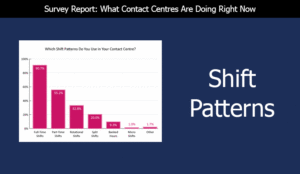To find what works best for most contact centres, we asked our readers: how far in advance do you publish your shifts or schedules to employees?
It Is Industry Standard to Publish 4–8 Weeks in Advance
Most of those who got back to us said that they publish their shifts four to eight weeks in advance, with no contact centre going beyond 12 weeks.
However, there were a number of alternative options, as some of our readers told us that they like to use rolling schedules instead, from six to ten weeks ahead.
But what is the best option for your contact centre? Let’s take a look at some of the factors that may influence your decision.
4 Key Factors That May Influence Your Decision
There a number of organisational and people factors that may influence your decision about when to publish your shifts. So, let’s look at four of them.
1. Confidence in Future Forecasts
Publishing shifts well in advance may seem to be in the best interests of the team. But if you do it too early, without regard to forecast volatility, these shifts will likely have to change. This then leads to frustrated advisors.
However, having confidence in your forecasts isn’t all about forecast accuracy. Although it can be an important measure, it provides little in terms of confidence for the planning assumptions of the future. So, it is more about how predictable the changes in workloads are.
This is a point that Phil Anderson, Head of Practice (Planning) at The Forum, makes: “because if your workloads can be quite volatile but predictable, you can put out your shifts quite far in advance.”
If you are susceptible to short-term changes, it’s about having the right flexibility levers in place.
Phil Anderson
“However, if you are susceptible to short-term changes, it’s about having the right flexibility levers in place. Even then, this tells you that you might be able to publish some things in advance for a long period of time, but you would want to be left with some short-term flexibility.”
For example, you could let advisors know if they are working the early, mid-shift, late-shift months in advance, but only give them exact times with a couple of weeks’ notice.
2. Team Demographic
Does everyone need the same notice for shifts? Perhaps not. In fact, being able to give willing members of the team shorter notice may boost flexibility.

Phil Anderson
As Phil Anderson says: “Not everyone is the same. So, for some people, having that certainty of shift is more important than anything else, whereas others just don’t mind.”
“For these members of the team, you can tell them a couple of days beforehand and that suits them and their potentially ‘chaotic’ lifestyle.”
3. Absenteeism and Sickness
Phil argues that “if your contact centre has high levels of absenteeism, you’ll need to make short-term changes and it could be wise to publish shifts further in advance.”
If you give advisors greater notice of their shifts, they can trade with other members of the team, if you have the capability to allow advisors to shift swap. However, when the team trade shifts, make sure it is with someone of the same skill set. An advisor on the voice channel swapping with a live chat advisor could really harm staffing levels.
Also, see if you can find a link between when you release your shifts and sickness levels. It could be useful to find this out before making changes to when shifts are published.
For more ideas on how to reduce rates of absenteeism in the contact centre, read our article: 46 Tips for Managing Absence
4. Annual Leave Processes
Think about your annual leave processes and how far in advance advisors can book time off. This is because when you’re in an environment where it can be difficult to get annual leave, some of the team may decide to play tricks, which will impact shifts, both short and long term.
Some advisors will book annual leave and then cancel it later, in the hope of getting better shifts.
Phil Anderson
Phil gives the example of such a trick, saying that “some advisors will book annual leave and then cancel it later, in the hope of getting better shifts.”
“However, if you can provide a guarantee of two weeks off every year, you’ll get people thinking about planning for getting that time off.”
Offering guarantees is a great way to get advisors to buy into their shift patterns and the notice that they receive. Other examples of these guarantees are discussed later.
What Stops You From Publishing Your Shifts Further in Advance?
While these are all factors that will influence your decision of when to publish your shifts, there are four more factors that you need to bear in mind.
Ultimately, if you cannot be sure of each of the following four factors, you should not publish your contact centre shifts.
- Uncertainty of demand
- Changing market conditions
- Volatile staffing/employee profile
- Ambiguity of multiskilling
However, if you are confident in each of these areas, go ahead and publish your schedules.
But remember, just because you have a high forecast accuracy, it doesn’t mean that you can be certain of demand.
As Phil says: “A big mistake with scheduling to a forecast demand is an obsession with forecast accuracy. It can be a huge error, along with the classic ‘try to be within plus or minus 5%’. This is because, mathematically, that is not a number that you can be accurate by.”
What Guarantees Can We Give the Team?
If you decide that it’s best to only publish shifts at four weeks’ notice, for example, the team will be more likely to buy into that idea if they can guarantee days off far in advance.
Here are two ideas that will help you to provide these guarantees.
Guarantee Holidays/Annual Leave With 10 Months’ Advance Notice
This can be a good idea, but watch out for your peak periods. For example, you may want to consider excluding Christmas from this guarantee (if this is a peak period for your contact centre), while Phil also suggests including a strict cancelling process.
In fact, Phil urges us to remember that the “aim is to encourage the use of annual leave and advance planning of time off.”
The worst-case scenario is that a lot of people all want the same time off. But, even then, you have at least got 10 months to find a solution.
Phil Anderson
“The worst-case scenario is that a lot of people all want the same time off. But, even then, you have at least got 10 months to find a solution.”
Encourage a Year’s Advanced Plan of Days Off
Most of the contact centre team will likely appreciate a long-term view of days off, to help them plan their lives and activities. A year in advance could be best practice, although you may want to exclude your peak periods, which will once again likely include Christmas.
Actual shift times can be confirmed nearer the time, while you may choose to stagger your shift publication as follows:
- Confirm working days 12 months in advance
- Confirm standard shift type (e.g. early, mid-shift, late-shift) six months in advance
- Confirm actual shift time (e.g. 08:45 until 17:15) one month in advance
Phil, who suggests this approach, says that it “provides certainty for the employee, with flexibility to the planning team to optimise staffing resource.”
Another idea – suggested by Shah, one of our readers – is to have a “six-week rolling schedule with two weeks’ locking. This has worked best for us and I have known it to be a system used in India, Dubai, Australia, Philippines, UK and US.”
This system would work by publishing shifts six weeks in advance. Advisors can swap shifts from two to six weeks out, but the shifts would lock from zero to two weeks.
Don’t Create a Rule That Is Unfair for Everyone
Earlier we highlighted the need to consider the team demographic before making a decision on how far in advance to publish shifts. Yet does everyone need the same notice?
As Phil Anderson says, “Remember, not everyone has the same level of expectation or need for certainty of shifts, so don’t create a rule which is unfair for everyone.”
Perhaps you can segment your team so their shifts are released in accordance with their preferences.
For example, you could offer a choice of four scheduling methods, which Phil Anderson highlights below.
1. Term-Time Shifts
Provide a 9–12 week view, with an annual review each summer holiday period. This is ideal for parents, who need to accommodate their children’s schedules.
2. Student Hours
Late notice (e.g. 1-week advance) may work best to support their university timetable, assignment deadlines/exams and social activities. These schedules will ideally be reviewed twice a year, at timetable release time.
3. Standard Rotational Patterns
Always complete the rotation, so provide advance knowledge of shifts for the length of the rotation pattern. This pattern should be reviewed at least once annually.
4. Annualised Hours
You should be able to provide a 12-month picture of the peaks and troughs, maybe confirming shift details shift nearer the time. Again, this shift pattern should be reviewed annually (or less often).
For more ideas of contact centre shift patterns, read our article: The Best Shift Patterns for the Contact Centre
What Are Our Readers Doing?
Let’s now hear from our readers about what they have found to be best practice from their very own contact centres.
Four Weeks Out
We publish four weeks in advance. I find anything further than that you are prone to having to make changes to shifts as holiday requests come through.
Being four weeks out also helps us to react to changes in customer behaviour, as we do not have to change everyone’s shifts to react, after it has already been published!
Thanks to Nick
Three Months Out
I plan shifts three months out and encourage the same on projects. I believe that true emergencies and medical appointments are the only real changes that should happen to a schedule inside 90 days.
I request all scheduled appointments, vacations, etc. to be known within this time period. I realise life happens and appointments move, but as much as possible respect, the 90-day schedule.
Thus, everyone knows what is expected and the time is long enough so that if a shift is not working, proper and unhurried modifications can be deliberated and implemented.
Also, I use scheduling planning software to plan changes to team schedules so those affected have 90 days to adjust mentally to any new schedules.
Thanks to Dave
Permanent Rotating Fixed Shifts
Permanent rotating fixed shifts for my team, because 80% of my work is email/ back-office tasks. However, we ensure that engagement is at premium, so that the team all work and flex to support the business and colleagues when needed.
I have found this to be the most beneficial to reduce attrition, attract talent and give colleagues great work–life balance.
Thanks to Penny
Ten-Week Rolling Schedule With Reserves
We use a ten-week rolling schedule. However, two of those ten weeks are called “reserves”, and shifts for those selected weeks will be rescheduled 2.5 weeks in advance.
Thanks to Luke
Let’s Change the Question
Instead of asking how far in advance do you publish your shifts or schedules to employees, for me, the question would be “what is your forecast accuracy trend/delta?”
In turn, this determines the flex you want to offer your frontline staff around schedule visibility, with a caveat of +/- variance depending upon your delta.
Not to forget – this may not work for all shapes and sizes; however, it does play a crucial role in determining your schedule visibility landscape.
Thanks to Punit
Summary
While the most popular option amongst our readers was to publish shifts 4–8 weeks in advance, there is no “one size fits all” answer, as highlighted by the comments made by our readers.
So, the contact centre must take into account organisational and people factors. Then, if the contact centre feels certain of demand, market conditions, employee satisfaction and multiskilling, they can publish their shifts.
To increase buy-in, you can then offer guarantees to advisors and perhaps offer certain employees greater notice than others, as long as everyone is happy.
For more on contact centre shift patterns, try reading our articles:
- 10 Ways to Make Scheduling Processes More Efficient
- 6 Things They Never Taught You About Shift Planning
- Building Flexibility Into the Schedule Using Banked Hours
Author: Robyn Coppell
Published On: 24th Sep 2018 - Last modified: 24th Apr 2024
Read more about - Workforce Planning, Forecasting, Phil Anderson, Scheduling, Shift Patterns, The Forum, Workforce Management (WFM)




































